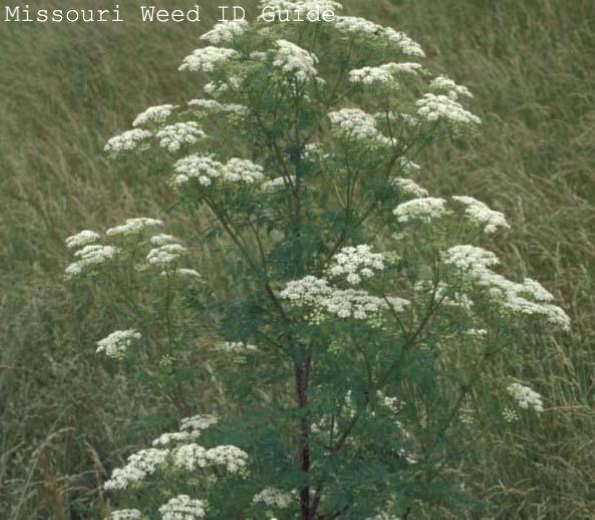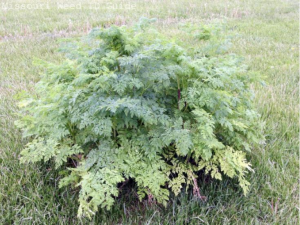By Kelly Nichols, Agriculture Agent Associate
University of Maryland Extension, Frederick County

Poison hemlock is a concern for both human and livestock health, and it is important to know how to identify and control it. It is typically seen along roadsides, fallow areas, fence rows, pastures, and creeks. Native to Europe, this weed is a biennial, completing its lifecycle in two years. In its first year, it will produce a rosette of leaves close to the ground (Figure 2). In the second year, it will bolt; this means that it will send up a stem, producing more leaves, flowers, and many seeds (Figure 1).
Poison hemlock is in the in carrot/parsley family. It does look similar to wild carrot (Queen Anne’s Lace); however, it is a larger plant, growing 4 to 6 feet tall when mature. Another key identifying feature of poison hemlock are the stems, which have purple spots and are hollow and hairless (Figure 3). The whole plant also has a musty smell.
Touching this plant has caused skin irritation. But it is also toxic if ingested by humans or livestock. It can take as little as 0.25% or 0.5% of a horse or cow’s weight, respectively, to cause poisoning and severe damage to the nervous system. That’s only 2.5 to 5 pounds of fresh material per 1,000 pounds of animal weight. If too much is ingested, it can cause death. Therefore, it is important to eradicate this weed in areas where livestock and humans could come into contact with it.
When working to control poison hemlock, always wear the correct personal protective equipment, including long sleeves, gloves, long pants, socks, and closed-toed shoes. Poison hemlock can be pulled out by hand if there are only a few plants. Mowing would slow growth and prevent seed production; however, this may not be the best option, as mowing would spread the plant material around.
Using a herbicide to control poison hemlock is best done in the spring before it bolts. Herbicides such as 2,4-D plus Banvel/Clarity, Crossbow (2,4-D + triclopyr), or glyphosate as a spot treatment will provide good control.


